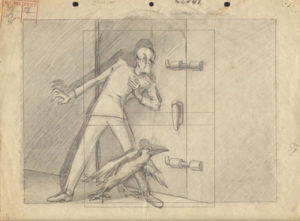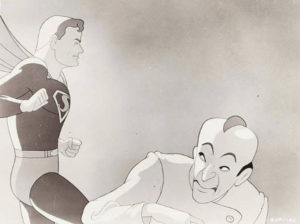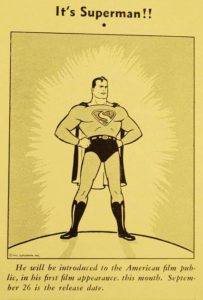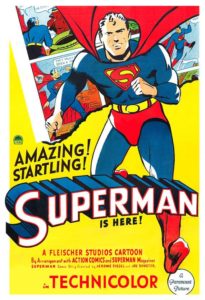Suspended Animation #208

The first Superman cartoons produced by Paramount in the early 1940s show the Man of Steel at the height of his popularity battling mechanical monsters, subduing an arctic dinosaur, thwarting an electrically induced earthquake and saving a tropical island from an erupting volcano.
“The Superman cartoons are great!” enthused Superman co-creator Jerry Siegel. “They’re full animation and the earlier ones adhere very closely to what we were doing in the comics.”
 In 1940, Superman was one of the most popular comic-book characters with regular appearances in both Superman and Action Comics, his own comic strip, a popular radio show begun in February and a host of top-selling merchandise in every department store in the nation. Superman was Super Business.
In 1940, Superman was one of the most popular comic-book characters with regular appearances in both Superman and Action Comics, his own comic strip, a popular radio show begun in February and a host of top-selling merchandise in every department store in the nation. Superman was Super Business.
It was natural that the next entertainment arena for the strange visitor from Krypton to conquer would be the motion picture screen. The August 28th, 1940 edition of Variety announced that Republic Studios, the major studio to produce weekly theatrical serials, had been negotiating for the rights to produce a Man of Steel serial but was unable to come to terms with the price for the character set by the comic book publishers. In addition, Republic had refused to give veto power to Superman’s parent company, National Periodical Publications, which the publisher firmly required.
Republic reformatted the script it had been developing for Superman into the serial Mysterious Dr. Satan (1940) featuring a un-super-powered hero named the Copperhead. The following year in 1941, Republic produced the highly popular serial The Adventures of Captain Marvel based on Superman’s biggest comic book competitor and, to add insult to injury, used the balsa-wood dummy it had built to be used in the proposed flying scenes for the Superman serial for the Big Red Cheese instead.
The September 4th, 1940 issue of Variety announced that a deal had been made with Paramount to produce the animated adventures of Superman. Paramount was deeply financially entwined with the Fleischer Studio, famous for its series of cartoons featuring Betty Boop and Popeye, and who had recently relocated to an expensive, brand new studio in Miami where it had produced its first feature length animated feature Gulliver’s Travels (1939).
 The announcement of the Superman series deeply concerned the Fleischer brothers, Max and Dave, for a number of reasons including the fact that for the first time Paramount was dictating what cartoons they would be making, and it foreshadowed future problems. Another concern was animating realistic-looking human figures rather than funny animals or exaggerated comic strip creations like Popeye, especially with the limited number of qualified animators who had any understanding of human anatomy.
The announcement of the Superman series deeply concerned the Fleischer brothers, Max and Dave, for a number of reasons including the fact that for the first time Paramount was dictating what cartoons they would be making, and it foreshadowed future problems. Another concern was animating realistic-looking human figures rather than funny animals or exaggerated comic strip creations like Popeye, especially with the limited number of qualified animators who had any understanding of human anatomy.
In addition, the Fleischers would not be able to participate in any of the merchandising profits from Superman as they had with Betty Boop and Gulliver’s Travels.
In an attempt to discourage Paramount, Dave Fleischer told the studio it would cost approximately $100,000 per cartoon (roughly four times the cost of an average cartoon) and would take seven months’ production time (more than twice the normal amount). To the Fleischer brothers’ surprise, Paramount agreed to the terms although later re-negotiated the cost to $50,000. Subsequent cartoons in the series were later budgeted at $30,000 each.
A series of model sheets for the characters had to be created using cube and block shapes rather than the traditional circles used for animated characters of the time. While a few scenes made use of the Fleischer rotoscope technique, the majority of the scenes were hand drawn. Expensive and time consuming character shadows, elaborate special effects animation and detailed animation layouts contributed to the attention to detail.
 The series marked the first time that a ring was around the globe of the Daily Planet. Studio publicity proclaimed that more than forty buckets of various colored paints were used to paint cels and backgrounds.
The series marked the first time that a ring was around the globe of the Daily Planet. Studio publicity proclaimed that more than forty buckets of various colored paints were used to paint cels and backgrounds.
The first Fleischer Superman cartoon, simply named Superman (although later referred to as the The Mad Scientist) took almost six months to complete and was released on September 26th, 1941. It begins with a short recap of Superman’s origin showing the explosion of Krypton. The sound of the explosion was the sound of an apple being wrenched in half which was then amplified to the decibel level of gunfire.
The voice of Superman for the series was provided by Bud Collyer who also performed Superman and Clark Kent’s voice during the radio series. Joan Alexander who portrayed Lois Lane in the radio show also did so in the animated cartoons. Collyer’s name remained a secret to audiences until 1946. Jackson Beck who would later be the narrator of the radio series starting in 1943 did voice work for the animated series.
Jack Mercer, well known as Popeye, provided the voice of the Mad Scientist. The design and attitude of the character was influenced by actor Boris Karloff’s character in The Black Cat (1934).
While Dave Fleischer is credited as director with story credited to Seymour Kneitel and Isidore Sparber, the key animators for this first outing were Steve Muffati and Franke Endres who for all intent and purposes actually directed the short under Fleischer’s supervision.
The story concerns newspaper reporters Clark Kent and Lois Lane being assigned to investigate the threat of a mad scientist who threatens to destroy Metropolis with his “electrothanasia ray” at midnight. Plucky Lois flies an airplane out to interview the scientist just as easily as most people drive a car and is captured.
 The ray blasts the Tower Bridge, sending cars and pedestrains tumbling to oblivion. Animator Sidney Pillet used a Paramount newsreel that recorded the crack-up of the Tacoma Narrows Bridge in Washingon in November 1940 as a guide. The sound of the death ray was created using the crackling and hissing of a sizzling steak.
The ray blasts the Tower Bridge, sending cars and pedestrains tumbling to oblivion. Animator Sidney Pillet used a Paramount newsreel that recorded the crack-up of the Tacoma Narrows Bridge in Washingon in November 1940 as a guide. The sound of the death ray was created using the crackling and hissing of a sizzling steak.
Hearing a report of the attack, Clark Kent transforms into Superman and uses his body to shield the Daily Planet building from the next attack. Superman literally punches the beam back to its source, causing the machine to blow up.
In the chaos of the destruction, Superman frees Lois and captures the mad scientist who is thrown in jail. Originally, Superman could leap an eighth of a mile (“able to leap tall buildings in a single bound”) but when that feat was animated, the Man of Steel looked like a grasshopper or a kangaroo. So with the permission of National Comics, Superman was given the power of flight that later was used in the comic books.
Superman received an Academy Award nomination as Best Animated Short but lost to Disney’s Lend a Paw with Mickey Mouse and Pluto. Superman’s success spawned a series of seventeen memorable cartoons.
Time Magazine in its June 1942 issue stated, “Some 20,000,000 Supermaniacs can hardly wait for Superman’s ten-minute, one-reel cartoon to appear in more than 7,000 movie houses. Artistically, Superman shorts are the movie cartoon at their worst. Superman looks and acts like a wooden pupet. So do all his playmates. There is little his creators – the old Fleischer Studios (now Famous Studios Inc.) at Miami, Florida – can do to improve their hero – even King Disney can’t animate human beings satisfactorily.”
You can judge for yourself:
Next week: The story of the sequel where the Mad Scientist escapes written by Jerry Siegel and seen by thousands of Superman fans but generally forgotten today.


 Jim Korkis is an internationally respected animation historian who in recent years has devoted his attention to the many worlds of Disney. He was a columnist for a variety of animation magazines. With his former writing partner, John Cawley, he authored several animation related books including The Encyclopedia of Cartoon Superstars, How to Create Animation, Cartoon Confidential and Get Animated’s Animation Art Buyer’s Guide. He taught animation classes at the Disney Institute in Florida as well as instructing classes on acting and animation history for Disney Feature Animation: Florida.
Jim Korkis is an internationally respected animation historian who in recent years has devoted his attention to the many worlds of Disney. He was a columnist for a variety of animation magazines. With his former writing partner, John Cawley, he authored several animation related books including The Encyclopedia of Cartoon Superstars, How to Create Animation, Cartoon Confidential and Get Animated’s Animation Art Buyer’s Guide. He taught animation classes at the Disney Institute in Florida as well as instructing classes on acting and animation history for Disney Feature Animation: Florida.




















































Great post, Jim. “Talk about swell!”
Fleischer had so many spectacular triumphs, it’s easy to give ’em a pass for their infrequent fails.
I’m lookin’ at you, Hunky and Spunky!
Congratulations and thanks for this superbly, interesting and entertaining posting.
Do we know how much time it took to gear up for that first Superman cartoon (and the subsequent series). After all, everyone involved had to “Beat The Clock” to get it to the theaters to comply with Paramount’s marketing plans…
This is a fantastic article. As author of THE ART AND INVENTIONS OF MAX FLEISCHER: AMERICAN ANIMATION PIONEER, I devote several pages to the development of the animated SUPERMAN series, begun by Fleischer Studios. In my research, I came across a detail that contradicts the story of Paramount approaching Fleischer to produce SUPERMAN and the associated resistance that Dave Fleischer has been quoted from his 1968 Oral History with Joe Adamson. I cite a Trade Announcement that states that the rights were being “given” to Fleischer Studios after the Republic deal did not materialize. Max had been considering doing cartoons of a “serious nature,” and the science fiction nature of SUPERMAN appealed to him. It is not credible to think that a cost of $100,000 was ever proposed in terms of the realistic position that Fleischer Studios was already in with Paramount, owing them money due to losses in film rentals starting in 1940 due to a year of bad product. under the leadership of Dave Fleischer. The costs of $50,000 and $30,000 were included in the 1941 Fleischer Contract, with Paramount provided financing as I state in my book. Paramount did not secure the character license, Max Fleischer did, as he had with Popeye. This is verified in the transfer of ownership documents of 1942 also referenced in my book. And as with the licensed Popeye, Fleischer did not share in merchandising since the property was not owned by Fleischer. This was the one weak point in Fleischer’s assets, the lack of marketable original characters beyond Betty Boop, which was also derivative. But so was Fred Flintstone, and we know where he went as a franchise.
I am a huge Ray Pointer fan and I am excited that you took the time to write in and add and correct information. I have a copy of your book and I am embarrassed to admit I haven’t gotten around to reading it yet since other responsibilities are constantly getting in the way. I am very much looking forward to it. I have a stack of books I know I will enjoy that are awaiting me finishing other writing deadlines and having some discretionary time to do so.
It should have occurred to me to refer to your book’s section about the Fleischer Superman cartoon but instead I relied on previous research I had done for articles about the Superman cartoons. That’s the exciting and frustrating thing about animation history. New research is always revealing new information and perspective and we can’t trust things we always thought we knew.
Glad you still liked the article and that I got a lot of things right. I hope you will enjoy next week’s article as well and maybe there might be a thing or two you never knew.
I love that the readers here are constantly supplying more information to the articles posted here.
Is there any possibility that you may scan the pages on feischer superman ? I am a superman fan from south america and would be very interested to read what you wrote about these cartoons..
I remember I first saw this short in the earliest days of the Sci-Fi Channel circa 1992-1993, when it ran as filler between programming blocks. And the line that stood out to me most is one that, as best I can tell, has been completely erased from all surviving copies that have been made publicly available. It happens at roughly the 3:15 mark of the video linked, when Clark says as the music crescendos “Chief, don’t you think that’s a dangerous mission f–” before fading to black. It’s a strange transition, since the fade out happens mid-sentence and isn’t quite in key with the score.
I can say with near 100% certainty that the original line as shown in 1941 was “Chief, don’t you think that’s a dangerous mission for a woman?” and I’m almost positive the version Sci-Fi Channel ran had that line in there. At some point it must have been edited to make it more appropriate for the modern era, though the later World War 2 themed Superman shorts with their less than flattering depictions of the Japanese remain intact. Does anyone else remember this? I would imagine with the Fleischer shorts being in the public domain–a concept likely to cease existing entirely soon–that unaltered copies would be floating around.
I have a high quality Super-8 public domain copy from the 1970’s with the line exactly as it is now. I do not believe it is cut for political correctness.
I had the original super eight film of the mad scientist the original line was “chief don’t you think that’s a dangerous job for a girl? “
I am very, very impressed with the quality of the short linked in this article. This one is totally devoid of splices, just as the cartoon appeared on VHS tape, along with the first and last episodes of the TV series, ‘THE ADVENTURES OF SUPERMAN”. I’m glad it was used for this article, and I remember really liking this series when I saw it, literally, on 1960’s local TV. I never knew this series existed until I woke up that fateful morning, perhaps a Thanksgiving Day morning, when it seemed that special marathons of cartoons were aired for the kids, and I was unfortunately only able to appreciate these in black and white, and I was in awe. If the Fleischers thought they failed in portraying the realism in fantasy with shadows and light technique, well, I didn’t notice any stiffness in the process upon watching the films that day. I’m happy these are all available, but it is my hope that they fully restore the entire series, with full openings and closings, perhaps for blu-ray someday, just as we’re getting the POPEYE shorts from the 1940’s. If this has already been done, please forgive my misconception here, and tell me where I can get a copy.
It’s interesting that the series didn’t survive the return of the studio from Miami to New York, even though the cartoons themselves apparently remained popular, if no longer the novelty that they were when they first came out. Most of the voices (Collyer, Alexander, Beck) and the music already were being recorded there for shipment to Miami, but the non-union wages Fleischer/Famous were able to pay in Florida, versus what Paramount knew the overall salaries were going to be back in NYC, may have made the cost/benefit ratio too low for the studio not to opt to replace licensing the Man of Steel with Little Lulu and the license-free Noveltoons.
In the mid-80s a friend bought a VHS tape of the Fleischer Superman cartoons from Rex Miller’s “Supermantiques” shop (Miller advertised heavily in CBG). Some of the cartoons were from B&W prints, though, and they had one of the title cards altered to remove Siegel and Shuster’s names. The color prints had the creators’ names intact.
I wonder if the original live action versions of the rotoscoped scenes still exist.
$50,000 in 1940 would be equal to $912,671.43 in 2019 dollars (the first Fleischer short)
$30,000 in 1941 would be equal to $521,526.53 in 2019 dollars (the last eight Fleischer shorts)
$30,000 in 1942 would be equal to $470,333.74 in 2019 dollars (the eight Famous Studio shorts)
So in total, the $530,000 spent on the 17 Superman cartoons, would be equal to $8,847,553.59 in today’s money.
Great piece, I enjoyed it.
Any live action reference footage would in all likelihood have been destroyed decades ago, if not deteriorated by this point in time.